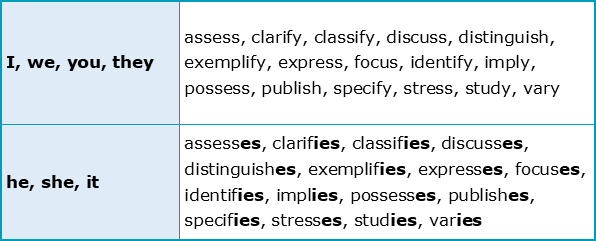How are present and past tense verbs formed?

This is the second of three chapters about Verb Tense. To complete this reader, read each chapter carefully and then unlock and complete our materials to check your understanding.
– Review the present and past tenses in English
– Explore how the present tense is conjugated, particularly for third-person singular subject forms
– Provide rules for forming the past tense in English and highlight the most irregular academic verbs
Before you begin reading...
-
video and audio texts
-
knowledge checks and quizzes
-
skills practices, tasks and assignments
Chapter 2

In the first chapter of this short reader on verb tense, we looked at how tense can be defined and recognised in verbs, learning that there are only two tenses in the English language: the present and the past. In this second chapter, we next focus more specifically on how to form the present and past tenses among both regular and irregular verbs. To accomplish this in academic contexts, we’ll draw on a list of 150 of the most frequent academic verbs, used widely in essays, journal articles and other academic publications.
1. How do I conjugate present-tense verbs?
For the most part, verbs in English are conjugated (formed) for the present in a very consistent way. There are two rules that students can follow:
- For first– and second-person singular subjects (‘I’, ‘you’ and ‘we’) and third-person plural subjects (‘they’), do not make any changes to the verb: [I learn / they learn].
- For third-person singular subjects (‘he’, ‘she’ and ‘it’), add the suffix ‘-s’ to the end of the verb to demonstrate the present tense: [he learns / she learns].
These two rules work perfectly for the majority of academic verbs:
accept, achieve, adapt, advance, affect, allocate, allow, alter, analyse, appear, argue, arise, assert, associate, assist, assume, attempt, avoid, base, benefit, cause, choose, cite, claim, combine, compare, compete, concentrate, conclude, conduct, connect, consider, consist, constitute, construct, contrast, contribute, correspond, decline, define, demonstrate, depend, describe, design, determine, develop, differ, display, effect, eliminate, emerge, enable, encounter, encourage, enhance, ensure, evaluate, evolve, examine, exceed, expand, explain, facilitate, favour, form, formulate, function, generate, highlight, illustrate, improve, include, increase, indicate, influence, interpret, introduce, investigate, involve, isolate, lead, limit, locate, maintain, measure, neglect, note, obtain, occur, outline, overcome, participate, perceive, predict, present, prevent, produce, prove, provide, pursue, quote, receive, reduce, reflect, regard, reinforce, relate, remain, remove, replace, report, represent, reproduce, require, resolve, respond, restrict, result, retain, reveal, rise, select, separate, show, solve, state, strengthen, submit, suggest, summarise, support, tend, transform, treat, undermine, undertake
Some verbs however, particularly those that end with ‘sh’, ‘ss’ or ‘y’ are formed differently for the third-person singular forms (‘he’, ‘she’ and ‘it’). In these cases, students should add the suffix ‘-es’ or replace ‘y’ with ‘-ies’:

2. How do I form past-tense verbs?
Thankfully, almost all of the 150 academic verbs provided above form the past tense by following one of three simple rules:
- Add the suffix ‘-ed’ to the end of the verb to form the past tense: [learn > learned].
- If the verb already ends in ‘e’, simply add ‘-d’ to the end of that verb: [perceive > perceived].
- If the verb ends in ‘y’, simply delete ‘y’ and add ‘-ied’ to the end of that verb: [vary > varied].

For a small number of academic verbs, however, there is no pattern for expressing the past tense. Instead, students will have to learn these verbs individually.
Common irregular academic verbs: [arise > arose; choose > chose; lead > led; overcome > overcame; rise > rose; undertake > undertook].
It’s important to note that English’s ten most common verbs are all also irregular. This means that while most verbs in English are in fact regular, because our most common verbs are not regular this irregularity seems more obvious.
Very common irregular general verbs: [be > was/were; come > came; do > did; get > got; go > went; have > had; make > made; say > said; see > saw; take > took].
Good work on completing this second chapter in our short reader on verb tenses. Now that we know how to form these two tenses in English, let’s take a look in our final chapter at how the past and present are used in academic contexts.
Downloadables
Once you’ve completed all three chapters in this short reader about Verb Tense, you might then wish to download our Chapter Worksheets to check your progress or print for your students. These professional PDF worksheets can be easily accessed for only a few Academic Marks.
Chapter 1 explores the topic: Is it true there are only two verb tenses in English? Our Chapter 1 Worksheet (containing guidance, activities and answer keys) can be accessed here at the click of a button.
Chapter 2 explores the topic: How are present and past tense verbs formed? Our Chapter 2 Worksheet (containing guidance, activities and answer keys) can be accessed here at the click of a button.
Chapter 3 explores the topic: How is verb tense used in academic English essays? Our Chapter 3 Worksheet (containing guidance, activities and answer keys) can be accessed here at the click of a button.
To save yourself 2 Marks, click on the button below to gain unlimited access to all of our Verb Tense Chapter Worksheets. This All-in-1 Pack includes every chapter, activity and answer key related this to topic in one handy and professional PDF.
Collect Academic Marks
-
100 Marks for joining
-
25 Marks for daily e-learning
-
100-200 for feedback/testimonials
-
100-500 for referring your colleages/friends